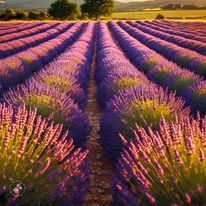Can lavender cultivation in Pakistan be a lucrative business venture? Is lavender the next big thing for Pakistani agriculture?
Explore the potential profitability of cultivating lavender, considering factors like climate, market demand, and the challenges involved. This is a must-read for those seeking new opportunities in Pakistan’s agricultural landscape.
For those seeking new avenues in agriculture, the fragrant allure of lavender beckons. But can cultivating this beautiful herb translate into a lucrative business venture in Pakistan’s diverse climate? Let’s delve into the potential and challenges of growing lavender commercially.
Thriving in Dry Climes:
Lavender flourishes in well-drained, sunny environments with moderate rainfall. This aligns well with the arid and semi-arid regions of Pakistan, particularly Balochistan, Khyber Pakhtunkhwa, and parts of Punjab. Success stories from Quetta, where lavender grows wild, suggest its potential in these areas.
Market Potential:
The global demand for lavender oil, used in cosmetics, aromatherapy, and even culinary applications, is on the rise. Pakistan, with its fertile lands and lower production costs compared to established players, could tap into this market. However, establishing a strong brand and ensuring consistent oil quality are crucial.
Challenges to Consider:
Pakistan’s monsoonal season with high humidity can be detrimental to lavender. Careful selection of lavender species suited to the climate, like English lavender (Lavandula angustifolia), is essential. Additionally, proper irrigation practices and drainage systems are vital to prevent root rot.
Knowledge and Infrastructure:
Expertise in distillation techniques for extracting essential oil is necessary. Collaborations with research institutions or essential oil producers in established lavender-growing regions could bridge this knowledge gap. Investment in distillation equipment would also be required.
The Road to Lavender Success:
While challenges exist, lavender cultivation holds promise in suitable regions of Pakistan. By focusing on the right variety, employing proper cultivation techniques, and establishing strong market linkages, this fragrant herb could blossom into a profitable agricultural venture.
The Final Bloom:
Further research on optimal growing conditions for lavender across Pakistan’s diverse climate zones is recommended. With careful planning, investment, and a touch of fragrant optimism, lavender cultivation could become a field of opportunity for Pakistani farmers.
Simplified text:
Is lavender easy to grow in Pakistan? What’s the selling price in Islamabad?
Expert translation:
This message inquires about the ease of cultivating lavender in Pakistan and the current market price in Islamabad.
کیا پاکستان میں لینڈر کی کاشت منافع بخش کاروبار ثابت ہو سکتی ہے؟
یہ سوال ان لوگوں کے لیے دلچسپی کا باعث ہے جو زراعت کے نئے امکانات تلاش کر رہے ہیں۔ مگر کیا پاکستان کے متنوع موسم میں اس خوبصورت جڑی بو کرنا ایک منافع بخش کاروباری منصوبے میں تبدیل ہو سکتا ہے؟ آئیے تجارتی طور پر لینڈر اگانے کی صلاحیتوں اور چیلنجوں پر غور کریں۔
خشک موسم میں ترقی:
لینڈر اچھی نکاسی والی، دھوپ والی جگہوں اور معتدل بارش والے ماحول میں پھلتا ہے۔ یہ پاکستان کے خشک اور نیم خشک علاقوں، خاص طور پر بلوچستان، خیبر پختونخوا اور پنجاب کے بعض حصوں کے ساتھ ہم آہنگ ہے۔ کوئٹہ سے کامیابی کی کہانیاں، جہاں لینڈر جنگلی طور پر اگتا ہے، ان علاقوں میں اس کی صلاحیت کا اشارہ دیتی ہیں۔
مارکیٹ کا امکان:
لینڈر کے تیل کی عالمی مانگ، جو کاسمیٹکس، اروماتھراپی اور یہاں تک کہ کھانے پینے کے استعمال میں آتی ہے، میں اضافہ ہو رہا ہے۔ پاکستان اپنی زرخیز زمینوں اور قائم شدہ کھلاڑیوں کے مقابلے میں کم پیداوار کی لاگت کے ساتھ، اس مارکیٹ میں شامل ہو سکتا ہے۔ تاہم، ایک مضبوط برانڈ بنانا اور تیل کی مستقل معیار کو یقینی بنانا ضروری ہے۔
غور کرنے کے لیے چیلنجز:
مون سون کی زیادہ نمی والا موسم لینڈر کے لیے نقصان دہ ہو سکتا ہے۔ موسم کے مطابق لینڈر کی اقسام کا محتاط انتخاب، جیسے انگلش لینڈر (Lavandula angustifolia)، ضروری ہے۔ اس کے علاوہ، جڑ سڑن کو روکنے کے لیے مناسب آبپاشی کے طریقوں اور نکاسی کے نظاموں کی ضرورت ہے۔
علم اور انفراسٹرکچر:
ضروری تیل نکالنے کے لیے تقطیر کی تکنیکوں میں مہارت ضروری ہے۔ تحقیقاتی اداروں یا قائم شدہ لینڈر اگانے والے علاقوں میں ضروری تیل کے پیداکاروں کے ساتھ تعاون اس علم کی کمی کو پورا کر سکتا ہے۔ تقطیر کے سامان میں سرمایہ کاری کی بھی ضرورت ہوگی۔
لینڈر کی کامیابی کی راہ:
اگرچہ چیلنجز موجود ہیں، پاکستان کے موزوں علاقوں میں لینڈر کی کاشت میں وعدہ ہے۔ صحیح نسل پر توجہ مرکوز کرکے، مناسب کاشتکاری کے طریقوں کو استعمال کرنے، اور مضبوط مارکیٹ روابط قائم کرکے، یہ خوشبودار جڑی منافع بخش زرعی کاروبار میں تبدیل ہو سکتی ہے۔
آخری بات:
پاکستان کے متنوع آب و ہوا والے علاقوں میں لینڈر اگانے کے لیے بہترین حالات پر مزید تحقیق کی سفارش کی جاتی ہے۔ محتاط منصوبہ بندی، سرمایہ کاری، اور خوشبو دار خوش بینی کے ساتھ، لینڈر کی کاشت پاکستانی کسانوں کے لیے مواقع کا میدان بن سکتی ہے۔
Great topic! Growing lavender in Pakistan can be a promising business venture, considering the country’s suitable climate and the global demand for lavender products. Here’s a comprehensive overview:
Market Potential
Pakistan’s lavender industry is still in its early stages, offering a first-mover advantage.
Global lavender market size is expected to reach $4.7 billion by 2028, growing at a CAGR of 12.6%.
Cultivation
Lavender requires a mild climate with well-drained soil and full sun.
Pakistan’s northern regions (e.g., Gilgit-Baltistan, Khyber Pakhtunkhwa) and the Potohar region (Punjab) have suitable conditions.
Planting season: September to November or February to April.
ROI (Return on Investment) Analysis
Initial investment (per acre): PKR 200,000 – 300,000 (approximately $1,200 – $1,800 USD)
Average yield per acre: 3-4 tons of dried lavender flowers
Price per ton (dried flowers): PKR 150,000 – 200,000 (approximately $900 – $1,200 USD)
Annual revenue per acre: PKR 450,000 – 800,000 (approximately $2,700 – $4,800 USD)
Net profit per acre: PKR 200,000 – 500,000 (approximately $1,200 – $3,000 USD)
ROI: 100% – 166% per annum
Value-Added Products
Essential oil extraction (high demand in cosmetics and pharmaceuticals)
Dried flowers for potpourri, crafts, and decorations
Lavender honey (bees are attracted to lavender)
Skincare products (creams, soaps, lotions)
Challenges
Limited awareness about lavender cultivation and processing
Inadequate infrastructure for drying and processing
Dependence on imported equipment and expertise
Government Support
Pakistan’s government offers subsidies and incentives for farmers and entrepreneurs in the agriculture sector.
The Ministry of National Food Security and Research provides support for crop diversification and value addition.
To get started, you may want to:
1. Conduct thorough market research and feasibility studies.
2. Visit lavender farms and processing facilities in Pakistan or abroad.
3. Consult with experts in agriculture, business, and marketing.
4. Develop a comprehensive business plan, including financial projections and marketing strategies.
Drying Infrastructure:
- Shaded Drying Areas: Large, well-ventilated areas with shade cloths are needed to dry the lavender quickly and evenly. Costs will depend on the size and materials used. A basic shade structure made with poles and shade cloth could cost around ₹100-200 per square meter. For a commercial operation, you might consider a covered barn-like structure with proper ventilation, which could cost upwards of ₹5,000 per square meter.
- Drying Racks: Wooden or metal racks are used to spread the lavender for efficient drying. Simple wooden racks can be built for a few thousand rupees, while multi-tiered metal racks can cost upwards of ₹20,000 depending on size and complexity.
Processing Infrastructure:
- Lavender Stripper: This machine separates the lavender flowers from the stems. Prices can range from ₹50,000 for a basic manual stripper to lakhs of rupees for an automated industrial model.
- Distillation Unit: The most crucial equipment. Lavender oil is extracted through steam distillation. A small-scale batch still can cost around ₹1 lakh to ₹3 lakh, while larger continuous stills can cost upwards of ₹10 lakh.
Additional Considerations:
- Storage: Proper storage facilities are needed for dried lavender and extracted oil. This might involve ventilated warehouses or containers depending on the scale.
- Transportation: Reliable transportation for moving harvested lavender to the processing unit is essential.
Total Cost:
The total cost of infrastructure can vary significantly depending on the scale of your operation. A small-scale setup might start with an investment of ₹2-3 lakh, while a larger commercial operation could require upwards of ₹20 lakh or more.
پاکستان میں تجارتی پیمانے پر لینڈر کو خشک کرنے اور پروسیسنگ کرنے کے لیے درکار انفراسٹرکچر کی following [निम्नलिखित (nīm following)] قسمیں ہیں، ان کی اندازہ لگائی گئی लागत (lāgat cost) کے ساتھ (ساتھ sāth with):
خشک کرنے کا انفراسٹرکچر:
- سائے دار خشک کرنے کے علاقے: لینڈر کو تیزی اور یکساں طور پر خشک کرنے کے لیے بڑے، اچھی وینٹیلیشن والے علاقوں اور سایہ دار کپڑوں کی ضرورت ہوتی ہے۔ اخراجات سائز اور استعمال شدہ مواد پر منحصر ہوں گے۔ پ柱وں اور سایہ دار کپڑے سے بنایا گیا ایک بنیادی سایہ دار ڈھانچہ ₹100-200 فی مربع میٹر کے لگ بھگ خرچ ہو سکتا ہے۔ تجارتی آپریشن کے لیے، آپ مناسب وینٹیلیشن کے ساتھ ڈھکے ہوئے بارن نما ڈھانچے پر غور کر سکتے ہیں، جس کی قیمت ₹5,000 فی مربع میٹر سے زیادہ ہو سکتی ہے۔
- **خشک کرنے کے ریک”: لینڈر کو موثر طریقے سے خشک کرنے کے لیے لکڑی یا دھاتی ریک استعمال کیے جاتے ہیں۔ کچھ ہزار روپے میں سادہ لکڑی کے ریک بنائے جا سکتے ہیں، جبکہ کثیر المنزلہ دھاتی ریک کی قیمت سائز اور پیچیدگی کے لحاظ سے ₹20,000 سے زیادہ ہو سکتی ہے۔
پروسیسنگ کا انفراسٹرکچر:
- **لینڈر سٹریپر”: یہ مشین لینڈر کے پھولوں کو تنوں سے الگ کرتی ہے۔ قیمتوں کا تعین بنیادی دستی سٹریپر کے لیے ₹50,000 سے لے کر خودکار صنعتی ماڈل کے لیے لاکھوں روپے تک ہو सकता ہے۔
- **ٹقطیر یونٹ”: یہ سب سے اہم سامان ہے۔ بھاپ کی تقطیر کے ذریعے لینڈر کا تیل نکالا جاتا ہے۔ چھوٹے پیمانے پر بیچ سٹل کی قیمت تقریباً ₹1 لاکھ سے ₹3 لاکھ تک ہو سکتی ہے، جبکہ بڑے مسلسل چلانے والے سٹلز کی قیمت ₹10 لاکھ سے زیادہ ہو سکتی ہے۔
اضافی نکات:
- **ذخیرہ”: خشک لینڈر اور نکالے گئے تیل کے لیے مناسب ذخیرہ کی سہولیات درکار ہیں۔ اس میں سکیل کے لحاظ سے وینٹیلیٹڈ گودام یا کنٹینر شامل ہو سکتے ہیں۔
- **ٹرانسپورٹ”: کٹائی گئی لینڈر کو پروسیسنگ یونٹ تک پہنچانے کے لیے قابل اعتماد نقل و حمل ضروری ہے۔
کل لاگت:
انفراسٹرکچر کی کل لاگت آپ کے آپریشن کے سائز کے لحاظ سے کافی حد تک مختلف ہو سکتی ہے۔ چھوٹے پیمانے پر سیٹ اپ ₹2-3 لاکھ کی سرمایہ کاری کے ساتھ شروع ہو सकता ہے، جبکہ ایک بڑے تجارتی آپریشن کے لیے ₹20 لاکھ یا اس سے زیادہ کی ضرورت پڑ سکتی ہے۔
مزید معلومات حاصل کرنا:
پاکستان میں زرعی آلات کے سپلائرز سے مشورہ کرنے کی سفارش کی جاتی ہے تاکہ خاص سامان کی تفصیلات اور قیمتوں کا علم ہو سکے۔ وہ آپ کی مخصوص ضروریات کے مطابق قیمتوں کی پیشکش کر سکتے ہیں اور آپ کے آپریشن کے سائز کے لیے موزوں سامان کی سفارش کر سکتے ہیں۔



